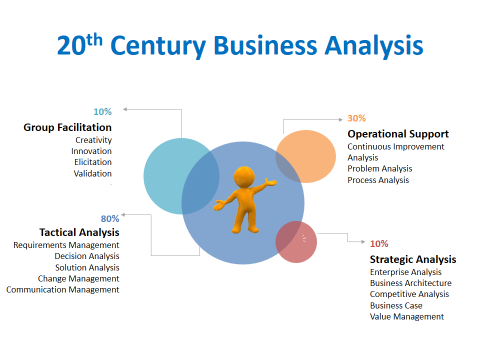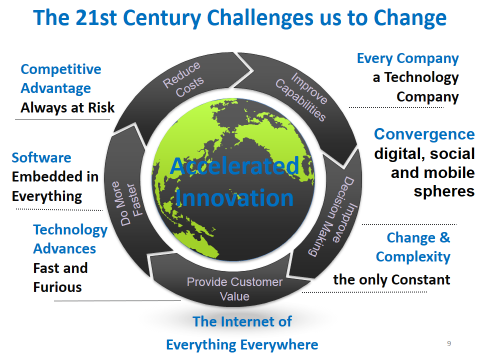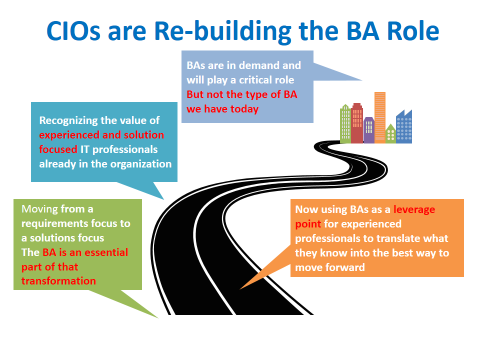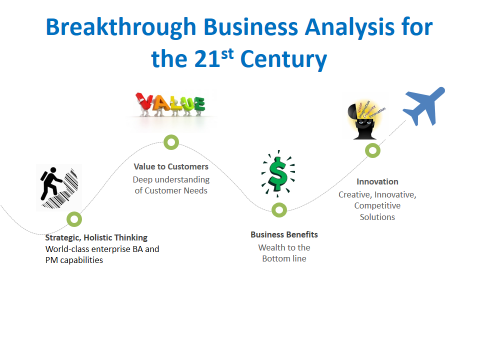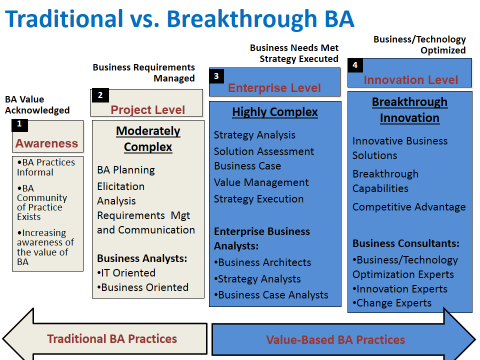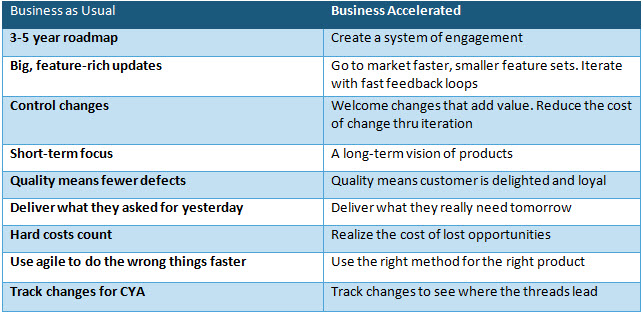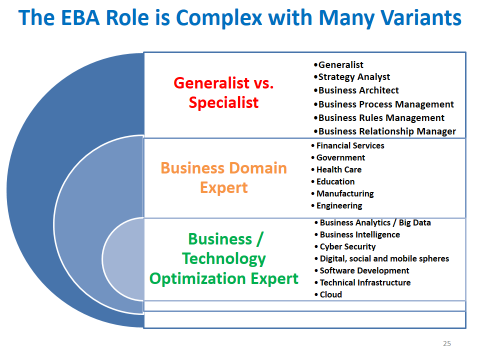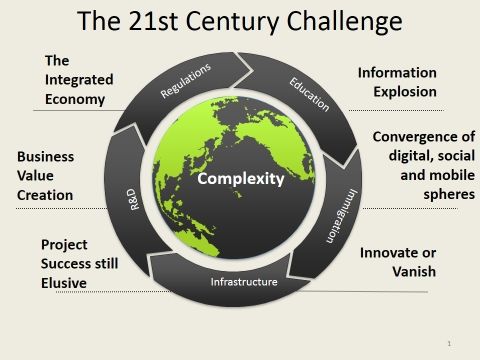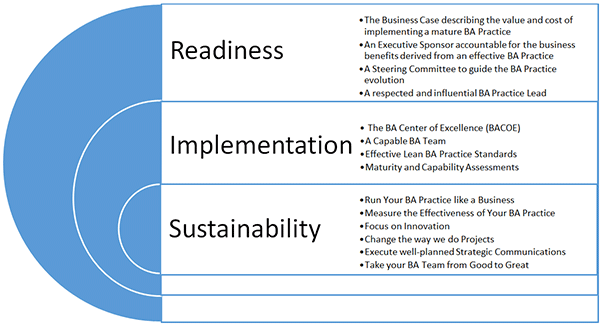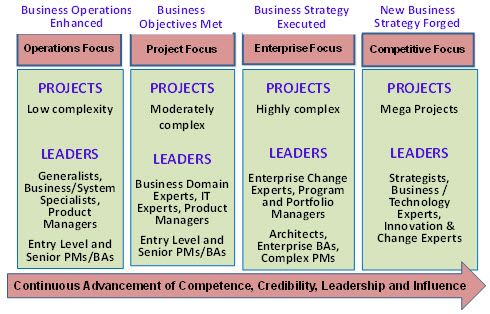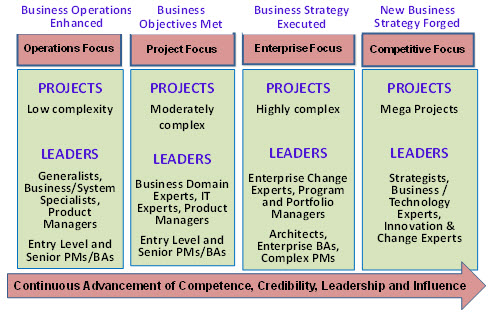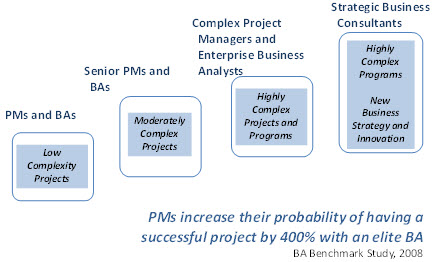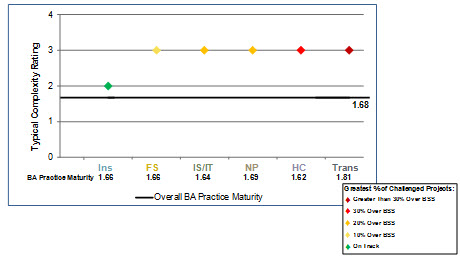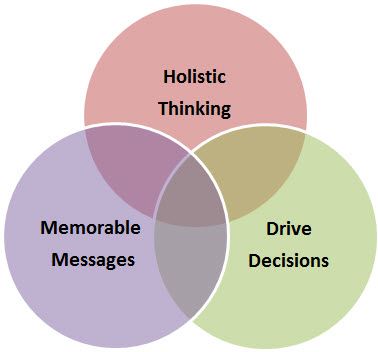Use strategic communications as your most effective tool to ensure you realize the full value of your BA Practice, and your organization knows it. Since project sponsors seldom measure accurately and then communicate the value derived from project and program solutions, the BA Practice Lead ensures these data are captured and shouted far and wide. An effective BA Practice focuses primarily on business value, the true measure of project management and business analysis effectiveness.
Strategic Communication
For the BA Practice Lead to be taken seriously and looked upon as a credible leader of change, she must engage in strategic communications. This involves:
- Thinking strategically, holistically, systematically
- Crafting powerful messages that are impactful and memorable
- Influencing positive decision making through intentional and targeted strategic communication
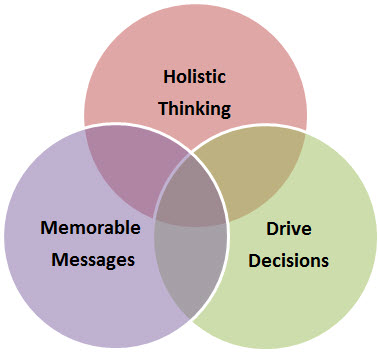
Strategic Thinking
To elevate your messages to make sure they are heard, begin to think differently about projects:
- Projects are essential to the growth and survival of organizations
- Through projects we innovate and adapt to changes in the environment, the competition, and even the marketplace
- Projects and project teams are our most effective tools used to execute strategy and therefore, to create value
- Holistic, systems thinking transforms our vision of project teams from tactical implementers to strategic executers of change
- Instill in your BA team the power of strategic thinking
It is critical for the BA Practice Lead to think and communicate holistically. In the context of business, holistic thinking takes into account the purpose, values, function, process, and structure of the organization. Holistic thinking forms the basis for everything BA Practice Leads do:
- Examining a complex system
- Developing the business design structure, the business model
- Problem solving
- Forming and executing strategy
- Communicating strategically
Holistic/systems thinking is the process of understanding how systems influence one another within a whole. In nature it applies to how ecosystems such as air, water, movement, plants, and animals work together to survive or perish. In the context of business solutions, it is the study of elements and their relationships with each other and with other systems, rather than in isolation. In organizations, systems consist of people, structures, data, processes, and technology that work together to make an organization functional or dysfunctional. The only way to determine why a problem or opportunity exists is to examine all elements within the system.
While analytical thinking involves understanding a system by thinking about its parts and how they work together to produce larger-scale effects, holistic thinking involves understanding a system by sensing its large-scale patterns and reacting to them. BAs need to understand the difference between the two types of thinking, and when to employ each.
- Holistic, systems thinkers get a general feeling about a situation to open their minds to subtle nuances of complex situations. They are often parallel processors, examining widespread simultaneous activity instead of a controlled, step by step process. They are often creative and intuitive, therefore focusing on the big picture and innovation.
- Whereas analytical thinkers understand how the components of the system function and work together. They usually possess good memories and pay close attention to the inner details of a situation.
The BA Practice Lead understands that her BA team is leading projects that are making changes to a set of parts connected by a web of relationships. Through these projects, her team is instrumental in executing strategy through multiple, interrelated projects. This is the story that needs to be told through strategic communications coming from BAs, and especially from the BA Practice Lead, for they are constantly participating in:
- Strategy Formation through enterprise analysis, competitive analysis and creative, intuitive thinking
- Strategy Decomposition to goals and objectives captured in the business case
- Strategy Execution through programs and projects
- Strategy Correction/Refinement as more is learned and the environment changes
- Strategy Measurement of progress along the journey
- Strategy Communication to describe the progress and demonstrate business benefits realized through projects.
Assess the Political Landscape
The first step in crafting your strategic communication plan is to assess the political landscape. Your organization is dynamic, adapting to changes all around. So, this assessment must be done often.
Understanding organizational politics facilitates strategic thinking. Make no mistake, organizational politics influence the success of your BA Practice and of the projects your BAs are leading. Organizational politics is comprised of the internal structures of your organization and how it deals with power and influence. Politics is neither good nor bad, it just is. Things happen when politics works:
- Decisions are made
- Projects move forward
- Deals are cut
- Goals are met
How can that be bad?
Positive politics gets positive results for the team, for the organization, and ultimately for you as BA Practice Lead. As a positive politician use your influence rather than authority or manipulation to achieve goals. Ensure you are operating from a positive position, a solid basis from which to influence, which includes:
- Status – your role as BA Practice Lead needs to be positioned high enough in your organization to command respect.
- Trust – your colleagues, whether on a peer level, above or below you on the organization chart must trust you. Trust is earned slowly through positive interactions.
- Integrity – never sacrifice your integrity. Never.
- Consistency – maintain a ‘steady as she goes’ posture. Carefully craft your communications so that they tell a story and are consistently positive and strategic oriented.
- Knowledge – become a quick study. Know what you are talking about, and know when to dive into the details and when to stay at the executive level. Know your audience, and what type of communication is appropriate to them.
To assess the political landscape, gather business intelligence about your customers, stakeholders, the environment, your status, the status of your BA team, and any landmines and risks. This is sort of like a stakeholder management approach on steroids.
Customer and Stakeholder Intelligence
Identify your customers and stakeholders that:
- Provide budget to your project
- Provide oversight
- Provide requirements
- Provide input
- Get output
- Depend on your deliverables
- Benefit from your project’s success
- Suffer from its success
Determine the level on involvement and importance. For each key customer/stakeholder, capture elements of business intelligence information:
- Role
- Awareness
- Opinion
- Importance
- Current level of support
- Level of support needed
Capture the information in a simple tabular format similar to the one below. Note: customize this and the other templates presented in the section to meet the unique needs of your organization.

Legend:

Influence Strategies
Then, identify the issues and concerns regarding the BA Practice that are important to each stakeholder. Ask: What’s in it for them? What do they need to view the BA Practice positively and actively support it? What actions will you take? Develop an influence strategy for each key stakeholder

The Political Environment
Work with your BA Practice Steering Committee to determine:
- Is the business case for your BA Practice solid? Can we demonstrate measurable results?
- Is the BA Practice politically sensitive?
- Are there major political implications?
- Is there impact to the core mission?
- Do you have a strong executive sponsor?
- What are the unspoken expectations?
- What is the decision-making process?
- What are the cultural norms?
- Is the communication and coordination effort challenging?
Capture the information in a simple tabular template.

Your Political Management Capabilities
Armed with this information about the political and cultural environment, work with your BA Practice Steering Committee to assess the political capabilities of your leadership, including how well you do the following:
- Enlisting the help of an executive sponsor
- Organizing and chairing your BA Practice steering committee
- Making yourself and your BAs experts about the business
- Promoting yourselves and your BA Practice
- Managing BA Practice benefits (ROI)
- Managing virtual alliances
- Facilitating, negotiating, and building consensus
- Managing conflict
- Developing a political management strategy for your BA Practice
Capture the information in a simple tabular template.

The Landmines and Risks
Using the information you have collected, assess the political risks to the sustainability of the BA Practice. Determine strategies to lessen the impact of the risks that may negatively influence the BA Practice, and leverage those that are positive. Work with your steering committee to devise strategies to:
- Gain high-level support
- Build alliances and coalitions
- Control critical resources (money, people, information, expertise)
- Control the decision process
- Control the steering committee process
Capture your political management strategies in a simple table similar to the one below.
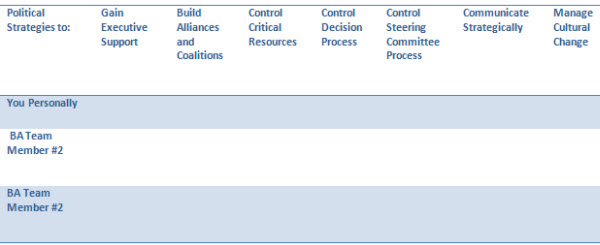
Political Management Plan
For each strategy, identify what success looks like. Focus on outcomes, how you will evaluate the effectiveness of the plan. Continually refine your strategy. Capture your success strategies in a simple tabular template.
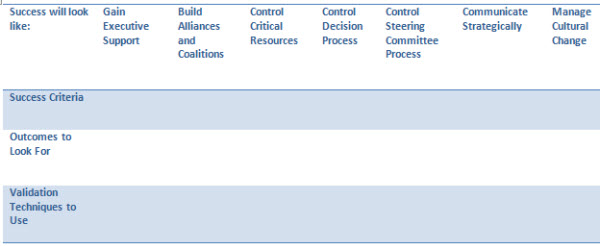
Craft Strategic Messages
Armed with the “business intelligence” you have captured, and your political management plan, you are now ready to begin to craft customized messages to your key stakeholders and customers.
Really Getting Heard
When presenting information to overworked executives, managers, employees, and distracted customers, you only have a few short minutes to get your message across. You need to become expert in: constructing memorable messages, customizing your message for the audience, really getting your message heard, and getting the decisions you want quickly so that forward progress is not stalled.
The Message
Compose a customized message for each key stakeholder. First, determine the purpose of the message. Is it simply to create awareness about your BA Practice objectives? Is it to enlist support for your BA Practice? Is it to dispel negative feelings about your BA Practice? Is it to make a decision about your BA Practice approach? Is it to gain support to resolve an issue?
Once the core purpose of the communication is understood, draft the message, composing it from the stakeholder’s perspective. Be sure to determine “What’s in it for them?” and tailor the message accordingly.
The Catch Phrase
“A minimum of sound to a maximum of sense.”
Mark Twain
Catch phrases adroitly capture the heart of your message. In the media world, catch phrases are referred to as sound bites, a very short piece of the message. It is a short phrase or sentence that deftly captures the essence of what you are trying to say. The goal is for the catch phrase to stand out in the audience’s memory; to be memorable; to clearly and cleverly make the point; to capture the heart of the message in a snippet. Examples of catch phrases include: “I have a Dream” “The Buck Stops Here” and “Joe the Plumber”.
The Slogan
A slogan is an effective technique that is used in advertising. It is also designed to make the message memorable. A slogan is a short phrase used as a rallying cry. It is intended to be motivational – to be a call to action. Examples of slogans include: “Don’t Leave Home Without It” “Yes We Can” “Just Do It” and “We’re the Dot in .com”.
The Pitch
You are now ready to develop your pitch, your “elevator speech” that takes no longer to deliver than thirty seconds and is about 100-150 words in length. Use a compelling “hook” that motivates people to further engage by including catch phrases and slogans. Capture your pitch in a simple tabular template.

Steer Your Steering Committee
Many BA Practice implementations are challenged – or even fail – because the project leadership team does not perform the critical analysis that is needed to determine the best path forward, at the start of the project and all along the way as more is learned and issues arise. The BA Practice Lead does not take the time to stop, analyze all possible solutions to business problems, or assess varying approaches before marching ahead. Once we are clear about the business problem or opportunity the BA Practice is going to solve, should we resource the practice in house? Do we have the appropriately skilled and talented BAs? Are they available? Do we need outside expertise? How fast do we need the practice to be fully functional? What are our competitors doing? The list goes on and on.
Getting the Decision You Want
When proposing a new initiative, escalating issues, proposing a course correction, securing the best resources for your practice, advocating to accept scope changes that add business value, you are essentially in a sales role, seeking approval from upper management. There are many pitfalls: management is impatient; we must not only be brief, we must also demonstrate the wisdom of the recommendation we are making. To do so, the wise BA Practice Lead works with an expert team to identify all potential options – fostering creativity and “out of the building” thinking. Then, you are ready to ask for a decision for your recommended option.
So, how can you make sure you get the decision you want? You need to facilitate BA team, augmenting it with additional SMEs who are influential, to analyze the issue, identify all potential options, and propose the most feasible solution. Use the results of your alternative analysis as decision-support information when presenting your recommended approach. Include the names of those who participated in the analysis, all the options considered, and the feasibility of each option: the economic feasibility, the time-to-market feasibility, the cultural feasibility, the technical feasibility, the success feasibility, the business process feasibility, the feasibility of achieving an innovative solution. After this analysis is complete, it is usually very clear which option is the most feasible. Capture your feasibility analysis in a simple Alternative Analysis Worksheet, and use it as decision support information when meeting with your BA Practice sponsor and steering committee.

Putting it all Together
So what does this mean for the Business Analyst?
Don’t let the political environment steer your project in the wrong direction. Establish Political Management and Strategic Communication Plans to negotiate environmental land mines, manage stakeholders’ influence, develop your political skills, respond to political risks, and seek approval for recommendations that are supported by rigorous alternative and feasibility analysis. Your team will respect you, and your management team will notice your logical and disciplined approach.
So what does this mean for the BA Practice Lead?
Model the process to create and execute Political Management and Strategic Communication Plans for your BA Practice implementation and sustainability approach. Require your BAs to employ some or all of these techniques as they negotiated the political landscape.
To communicate effectively, the BA Practice Lead prepares unique communication strategies for the major stakeholders of the BA Practice. Your goal is to explain the value of Business Analysis, driving an understanding of the WIIFM (What’s in it for me?) for all key stakeholders. Effective communications involves an enterprise focus, an emphasis on executing strategy and advancing enterprise capabilities, delivering innovative products and services, and measuring and communicating improved project outcomes.
Strategic communication requires targeted approaches for each key stakeholder. First, identify WIIFM for each key individual and group (refer back to article 2 for ideas).
- What’s in it for the CIO? The CFO? The CEO?
- What’s in it for the Business Manager?
- What’s in it for the Technologists?
- What’s in it for the Project Manager?
- What’s in it for your customers?
Then, devise a customized communicate strategy and key messages for each stakeholder. Convert the messages to a short, concise ‘elevator speech’. Determine the appropriate media and timing of the communication. Focus communications on how projects using mature BA practices produce value to the customer and wealth to the bottom line. After each communiqué, determine the effectiveness of the message, and make improvements to it for the next time.
Some content is adapted with permission from The Enterprise Business Analyst: Developing Creative Solutions to Complex Business Problems by Kathleen B. Hass, PMP. © 2011 by Management Concepts, Inc. All rights reserved. The Enterprise Business Analyst: Developing Creative Solutions to Complex Business Problems
Don’t forget to leave your comments before.
